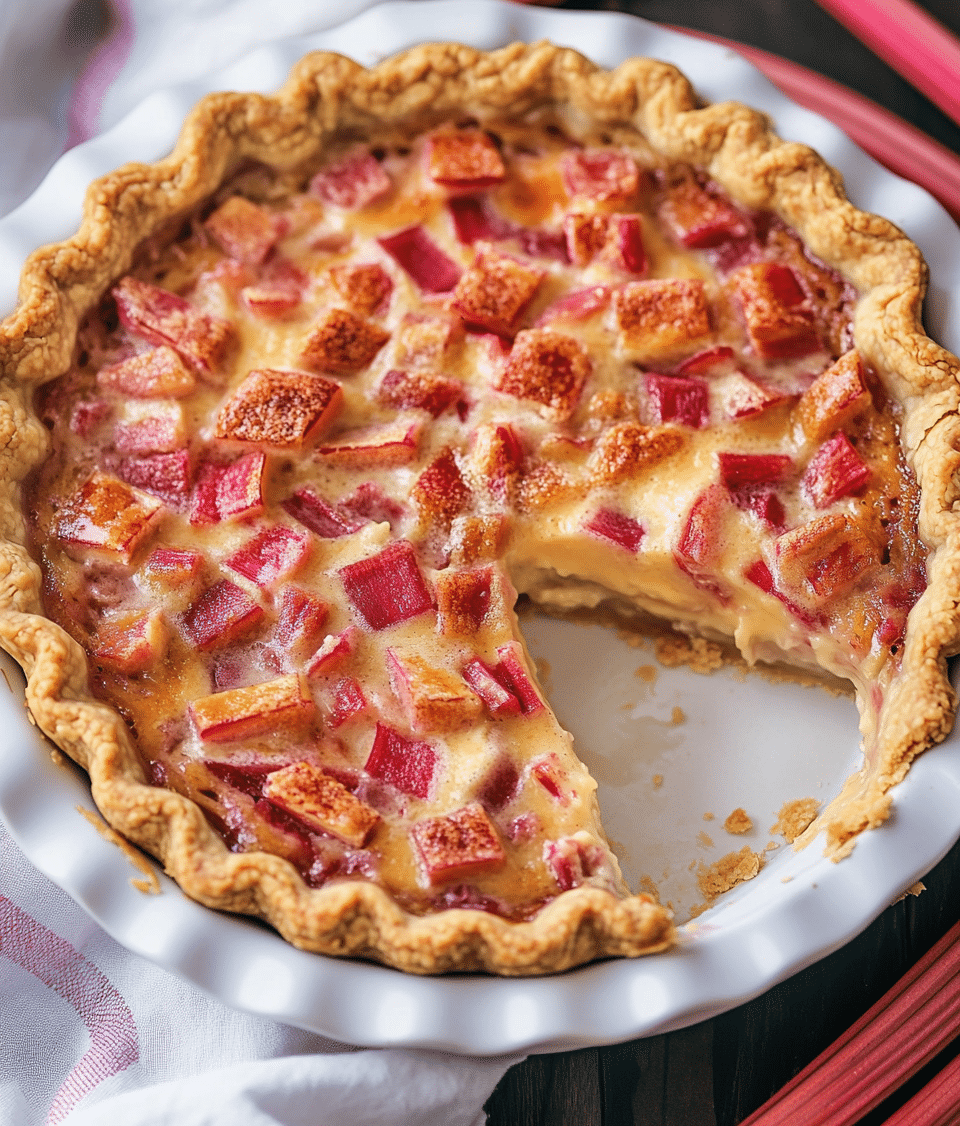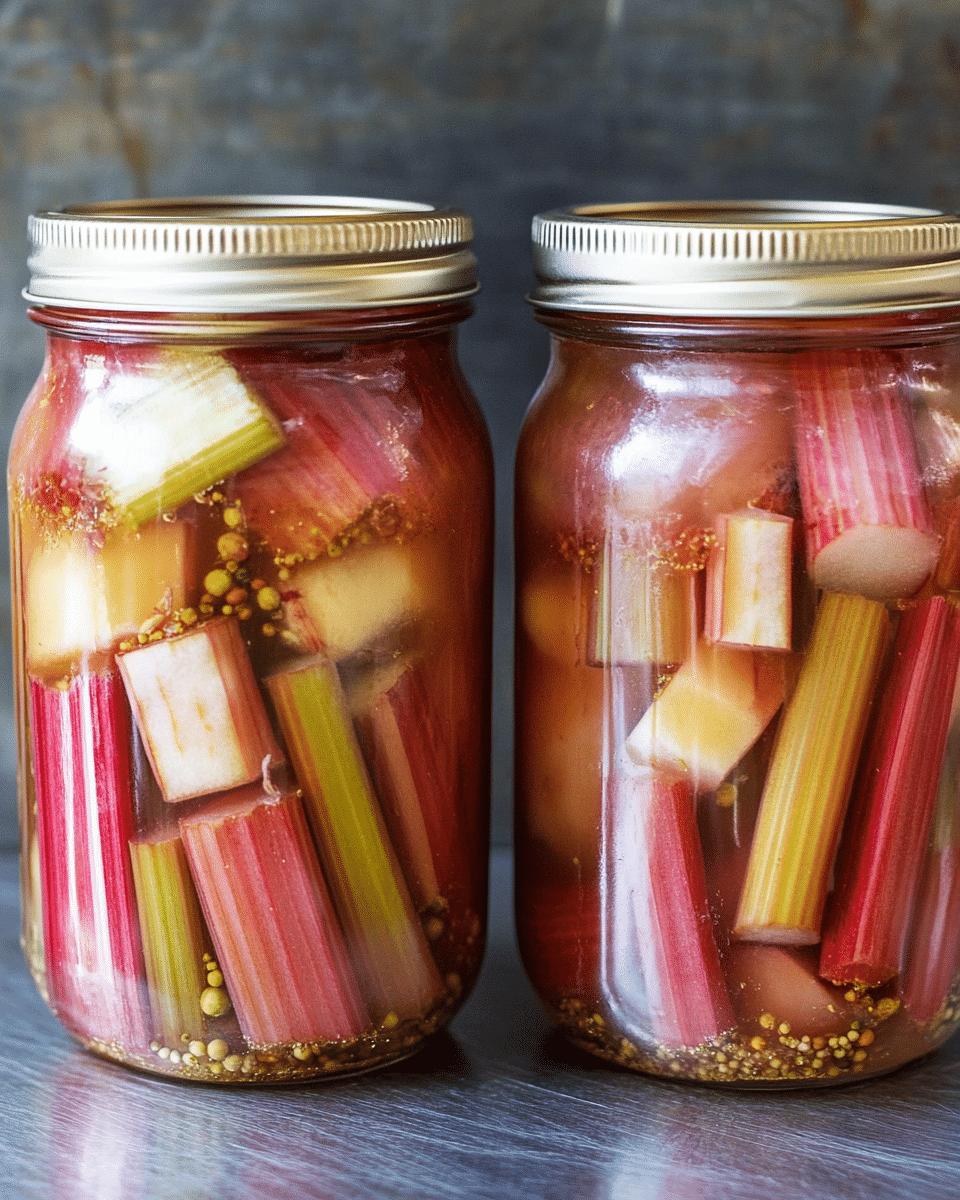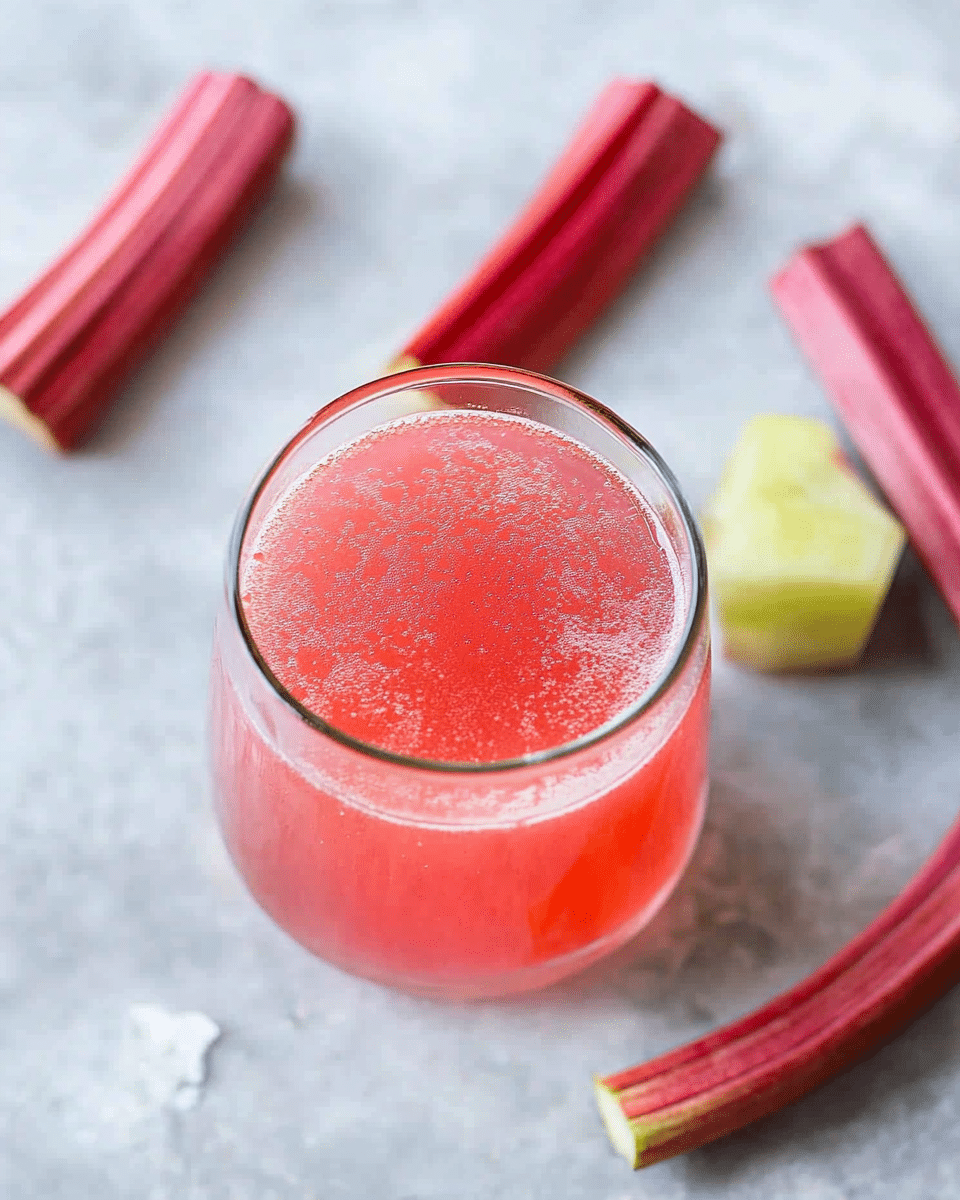This classic rhubarb custard pie is a delightful vintage dessert that combines the tartness of rhubarb with a smooth, creamy custard filling. It’s easy to make and perfect for sharing at any gathering or simply enjoying as a nostalgic treat.
FULL RECIPE
Ingredients
- 1 9-inch pie crust (pre-made or homemade)
- 4 cups fresh rhubarb, chopped
- 1 ½ cups granulated sugar
- 3 large eggs
- 1 ½ cups whole milk
- 1 teaspoon vanilla extract
- 3 tablespoons all-purpose flour
- ¼ teaspoon salt
Directions
- Preheat the oven to 375°F (190°C).
- Place the pie crust in a 9-inch pie pan and set aside.
- Spread the chopped rhubarb evenly over the bottom of the pie crust.
- In a mixing bowl, whisk together the sugar, eggs, milk, vanilla, flour, and salt until smooth.
- Pour the custard mixture over the rhubarb in the pie crust.
- Bake for 45-50 minutes, or until the custard is set and the crust is golden brown. A knife inserted near the center should come out clean.
- Remove from the oven and let cool completely before serving.
Nutritional Information
- Calories: 260 kcal
- Total Fat: 7 g
- Saturated Fat: 3 g
- Cholesterol: 85 mg
- Sodium: 120 mg
- Total Carbohydrates: 42 g
- Dietary Fiber: 2 g
- Sugars: 30 g
- Protein: 5 g
The History of Rhubarb Custard Pie
Rhubarb custard pie has deep roots in American and British culinary traditions, especially popular in the early to mid-20th century. Rhubarb was often called the “pie plant” because it was one of the few fresh vegetables available in early spring, making it a favorite for home cooks who wanted to brighten their dessert tables after long winters. Combining rhubarb with custard made for a smooth, balanced dessert where the tartness of rhubarb contrasted beautifully with the creamy sweetness of the custard. This pie reflects a time when seasonal and homegrown ingredients were central to cooking.
Why Rhubarb is Perfect for Baking
Rhubarb’s natural tartness is its signature trait, which makes it ideal for desserts because it balances sweetness without becoming overpowering. When baked, rhubarb softens but retains a slight texture, adding a pleasant contrast to smooth custard or flaky crust. The vegetable’s high acid content helps break down sugars more effectively during baking, resulting in a well-rounded flavor profile. This unique characteristic makes rhubarb especially suitable for pies, crisps, and tarts.
Nutritional Benefits of Rhubarb
Rhubarb is low in calories and carbohydrates but high in dietary fiber and vitamins such as vitamin K and C. It is also a good source of antioxidants, which can help protect the body from oxidative stress and inflammation. Despite being a vegetable, rhubarb is most commonly enjoyed in sweet dishes, making it a nutritious option for those who want to indulge without consuming excessive sugar or fat. The fiber content also supports digestive health and helps maintain a feeling of fullness.
Understanding the Custard Filling
Custard is traditionally made from eggs, milk, and sugar, providing a rich and creamy texture that complements the tart rhubarb perfectly. The proteins in eggs coagulate as they cook, thickening the filling and giving it a delicate firmness while remaining soft and silky. The milk adds moisture and richness, while sugar balances the tartness of rhubarb. Properly cooked custard is smooth without curdling, which requires careful temperature control during baking.
The Importance of a Good Pie Crust
A sturdy yet flaky pie crust is essential for this pie because it needs to hold the moist custard and juicy rhubarb without becoming soggy. A well-made crust provides a textural contrast that enhances the overall eating experience. Many bakers prefer a buttery shortcrust pastry, which adds flavor and richness while creating the perfect base. Blind baking the crust slightly before adding the filling can help prevent it from becoming soggy.
How to Choose Fresh Rhubarb
When selecting rhubarb for pie, look for firm, brightly colored stalks that snap easily when bent. Avoid stalks that are wilted, bruised, or have blemishes. The color of rhubarb can range from light pink to deep red; generally, darker stalks tend to be sweeter, though the difference is subtle. Leaves should be avoided entirely, as they contain toxins and are not edible.
Variations on Rhubarb Custard Pie
Many variations exist depending on personal taste and regional influences. Some recipes include additional fruits like strawberries or raspberries to complement rhubarb’s tartness. Others may swap whole milk for cream to make the custard richer or add spices like cinnamon, nutmeg, or ginger for warmth. The crust may also vary, with some using graham cracker or almond flour crusts for a different texture and flavor.
Serving Suggestions and Pairings
Rhubarb custard pie is delicious on its own or served with accompaniments like whipped cream, vanilla ice cream, or a drizzle of caramel sauce. Its tart and creamy profile pairs well with sweet and creamy sides that balance its acidity. For an elegant presentation, a dusting of powdered sugar or a sprig of fresh mint adds visual appeal and freshness.
Seasonal Appeal and Availability
Rhubarb is typically in season from early spring to early summer, making this pie a wonderful way to celebrate spring’s arrival. Using fresh, seasonal rhubarb enhances the flavor and texture of the pie. Outside of rhubarb season, frozen rhubarb is a good alternative but may release more liquid, which requires adjustments to the recipe to avoid a watery filling.
Common Mistakes to Avoid
Overbaking custard pie can cause the filling to crack or become rubbery, while underbaking may leave it too runny. Similarly, failing to pre-bake the crust can result in sogginess. Not balancing the sugar properly can leave the pie too tart or overly sweet. Paying attention to these details ensures a perfect custard pie every time.
Tips for Baking Success
Using an oven thermometer can help maintain consistent temperature for even baking. Letting the pie cool completely before slicing helps the custard set fully and prevents it from spilling out. Covering the crust edges with foil halfway through baking prevents over-browning. Using room temperature ingredients can also help the custard mix evenly.
Cultural Significance and Nostalgia
Rhubarb custard pie often evokes nostalgia for many families, reminding them of homemade pies made by grandparents or seasonal celebrations. It symbolizes the comfort and simplicity of home baking and is a staple in many traditional cookbooks. Its enduring popularity highlights how certain recipes connect generations through shared food memories.
Conclusion
Easy rhubarb custard pie is more than just a dessert — it’s a flavorful blend of history, tradition, and nutrition. Its perfect balance of tart rhubarb and smooth custard combined with a flaky crust creates a satisfying treat that appeals to both nostalgic and modern palates. Whether you enjoy it fresh in spring or try variations year-round, this pie remains a beloved classic in the baking world.








